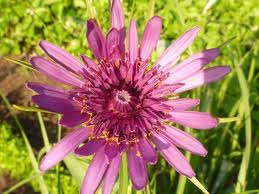When looking through old cookbooks (I mean the really old ones) it is surprising how many different vegetables are mentioned that we have completely forgotten about. Most of us know that dandelions were once a commonly used green, but who has heard of marhsmallow? I am talking about the plant and not the little white sugar balls that make a camp fire complete. We know Solomon's seal as a horticultiural addition to our gardens, but did you know that it is edible and delicious at that too?
One of those long forgotten vegetables that once used to be a staple food amongst many Europeans and also the settlers of America is salsify. Salsify (Trappogon porrifolius) is currently making a bit of a comeback in the foodie scene and I always have to grin when I hear about this "new food" that is hitting the market.
Salsify is a plant from the Aster family. It is a bi-annual, meaning it flowers in its second year with some wonderfully showing flowers that depending on the variety can be purple, yellow or pale near to white. The most common vegetable variety is the purple one. Different parts of the plant are edible but for the most part the thick taproots are used along with the young tender leaves. The roots are similar to that of dandelion but have a dark skin with brilliantly white flesh inside. A thick creamy white liquid can be pressed from the roots when cut.
We planted some salsify last year and most of the plants came up. At first it looked a lot like wheat grass. In the fall some deer mowed all of the leaves right down to the ground, sparing the lettuce that was growing right beside it. I can only assume that the leaves were more appealing to the deer. Since the plant is a bi-annual I didn;t care about the deer getting a meal out of our garden....we are after the roots in any case. This year all of the plants came back and started to produce lovely big flowers. Apparently these flowers are supposed to open and close with the sun, but I have only seen the flowers open once and that was early in the morning. I assume that whatever variety I have is a night bloomer as some of the flower heads are starting to form seeds and as I said, they don't open during the day.
 |
| Salsify flower |
 |
| Fresh out of the ground |
There are also some conflicting reports about when to harvest the root. Some sources suggest to harvest the roots at the end of their first year after the first frost which is supposed to bring out the flavour best. Other sources say to harvest the roots after the plant has bloomed. I think we left it a little too long, so when the flowers are out before the seeds form might be the best time. The roots aren't as large as carrots would be, but still are of formidable size.
 |
| After cleaning. Not the prettiest vegetable in the world. But tasty...yum yum. |
There are many different recipes that can be found when searching then web. I scrubbed the root and scraped off the hard outer rind. The white flesh were chopped into small pieces and fried in a pan with some olive oil until they were golden brown. Since we didn't have much salsify this year (we just wanted to try it out), I decided to throw the pieces into a salad. The taste is fantastic. I can't really put my finger on it, but it did remind me of something. There was some sweet component to it. I think you will just have to try it for yourself. It definitely does not taste of oysters which it apparently does....the plant is also referred to as vegetable oyster. So far I found no one who could confirm that. In fact the internet is full of statements that it does NOT taste of oysters.
I collected a lot of the seeds this year, so that I can seed it out again. This time I will grow more, a lot more. Why not try it yourself. Give the old chap a chance.
No comments:
Post a Comment